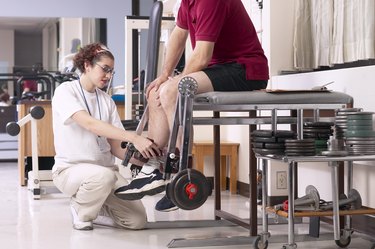
Your knee acts as a hinge, connecting the thigh and shin bones. The anterior cruciate ligament, or ACL, is one of four that connect these bones, running outside the knee to keep it from bending outward. Injuries to the ACL usually occur during sporting activities when the knee twists, causing the ligament to tear. Losing weight requires that you eat fewer calories than you burn off through normal activities and exercise. After surgery, you can control your diet and as you heal, your capacity for exercise will increase.
Post-Surgery Exercises
Video of the Day
Step 1
Use a continuous passive motion, or CPM, machine daily as instructed by your doctor or physical therapist. The CPM helps you regain flexibility in your knee, which is crucial to ensure you can exercise effectively to lose weight.
Video of the Day
Step 2
Use crutches for walking and build up your knee's ability to withstand weight over time. The Nicholas Institute of Sports Medicine and Athletic Trauma estimates that you will need crutches for up to two weeks post-surgery.
Step 3
Perform exercises as directed by your physical therapist. For example, the Nicholas Institute recommends hip abductions and adductions, straight leg raises and seated passive knee lifts. These exercises burn calories while strengthening your hip and thigh muscles and flexing your knee.
Step 4
Use weights to build muscle and burn calories in your upper body.
Exercises for Rehabilitation and Beyond
Step 1
Use a stationary bicycle or perform leg presses using light weights to build strength and burn calories. The University of California San Francisco Medical Center says that these exercises strengthen the thigh muscles and protect the ACL by using the hamstring.
Step 2
Burn calories by swimming with your upper body only, after your doctor releases you to be submerged. Do not use your legs or feet to paddle until advised by your physical therapist.
Step 3
Continue burning calories in your upper body by lifting weights and performing abdominal exercises as directed by your physical therapist.
Step 4
Expand your exercise routine to include jogging, swimming and other weight-bearing aerobic exercises as your physical therapist recommends. The more exercise you perform, the more calories you burn.
Eating Right
Step 1
Control the calories you eat. The MyPyramid.gov website recommends calorie consumption by gender, age and lifestyle. For example, women ages 19 to 30 who do not exercise need 2,000 calories per day. Men in the same age and activity category need 2,400 calories per day. Talk to your physical therapist about how many calories are right for you.
Step 2
Eat lean protein, such as fish or skinless chicken and turkey, to help your body repair the muscles around your surgical site.
Step 3
Include fresh fruit and vegetables in your diet because they are low in calories and provide you with vitamins and minerals to help the healing process.
Step 4
Avoid calorie-rich foods, such as high-sugar foods like soft drinks and candy, and high-fat foods like French fries.
Step 5
Drink eight 8-oz. glass of water each day to keep your body hydrated. Water also helps you feel less hungry.
Step 6
As your exercise regimen increases, ask your physical therapist about increasing your daily caloric intake.
Things You'll Need
Continuous passive motion machine
Weight machine or free weights
Stationary bicycle
Tip
Use an ice pack to reduce swelling in your knee after exercising.
Warning
Do not exceed your doctor or physical therapist’s guidance on exercising after ACL surgery. Too much physical activity performed too quickly after surgery can cause additional damage to your knee.